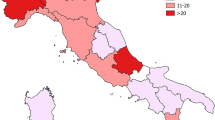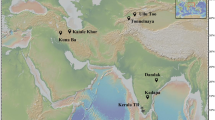Abstract
The seasonality of cholera and its spatial variability remain unexplained. Uncovering the role of environmental drivers in these seasonal patterns is critical to understand temporal variability at longer time scales, including trends and interannual variability. Rainfall has been proposed as a key driver of the seasonality of cholera. To address this hypothesis, we examine the association between rainfall and cholera in both time and space using the extensive historical records for the districts of Madras in former British India (1901–1940). We show the existence of two main spatial clusters that differ not just in the effect of rainfall but also in the seasonal pattern and frequency of periods with and without cholera mortality. The results support a model of cholera seasonality with two different routes of transmission: one is enhanced by increasing rainfall (in areas with abundant water), the other is buffered by increasing water. We discuss how the dual nature of the influence of rainfall creates different temporal patterns in regions where cholera is either “endemic” or “epidemic.”








Similar content being viewed by others
References
Anselin L (1995) Local indicators of spatial association—LISA. Geographical Analysis 27:93–115
Bailey TC, Gatrell AC (1995) Interactive Spatial Data Analysis, Harlow, UK/New York: Longman Scientific & Technical; New York: John Wiley & Sons
Bartlett MS (1957) Measles periodicity and community size. Journal of The Royal Statistical Society Series A—General 120:48–70
Bjornstad ON, Ims RA, Lambin X (1999a) Spatial population dynamics: analyzing patterns and processes of population synchrony. Trends in Ecology & Evolution 14:427–432
Bjornstad ON, Stenseth NC, Saitoh T (1999b) Synchrony and scaling in dynamics of voles and mice in northern Japan. Ecology 80:622–637
Bouma M J, Pascual M (2001) Seasonal and interannual cycles of endemic cholera in Bengal 1891–1940 in relation to climate and geography. Hydrobiologia 460:147–156
Cliff AD, Ord JK (1973) Spatial Autocorrelation, London: Pion
Codeco CT (2001) Endemic and epidemic dynamics of cholera: the role of the aquatic reservoir. BMC Infectious Diseases 1:1
Colwell RR (1996) Global climate and infectious disease: the cholera paradigm. Science 274:2025–2031
Colwell RR, Kaper J, Joseph W (1977) Vibrio-cholerae, Vibrio-parahaemolyticus, and other Vibrios—occurrence and distribution in Chesapeake Bay. Science 198:394–396
Faruque SM, Bin Naser I, Islam MJ, Faruque ASG, Ghosh AN, Nair GB, et al. (2005) Seasonal epidemics of cholera inversely correlate with the prevalence of environmental cholera phages. Proceedings of the National Academy of Sciences of the United States of America 102:1702–1707
Fortin M-J, Dale MRT, ver Hoef J (2002) Spatial analysis in ecology. In: El-Shaarawi AH, Piegorsch WW (editors), Encyclopedia of Environmetrics, Vol 4, Chichester, UK: John Wiley & Sons, pp 2051–2058
Glass RI, Claeson M, Blake PA, Waldman RJ, Pierce NF (1991) Cholera in Africa—lessons on transmission and control for Latin-America. Lancet 338:791–795
Hartley DM, Morris JG, Smith DL (2006) Hyperinfectivity: a critical element in the ability of V. cholerae to cause epidemics? PLoS Medicine 3:63–69
Islam MS, Mahmuda S, Morshed MG, Bakht HBM, Khan MNH, Sack RB, et al. (2004) Role of cyanobacteria in the persistence of Vibrio choterae O139 in saline microcosms. Canadian Journal of Microbiology 50:127–131
Kaper JB, Morris JG, Levine MM (1995) Cholera. Clinical Microbiology Reviews 8:48–86
Keeling MJ (1997) Modelling the persistence of measles. Trends in Microbiology 5:513–518
Koelle K, Pascual M (2004) Disentangling extrinsic from intrinsic factors in disease dynamics: a nonlinear time series approach with an application to cholera. American Naturalist 163:901–913
Koelle K, Pascual M, Yunus M (2005a) Pathogen adaptation to seasonal forcing and climate change. Proceedings of the Royal Society of London. Series B: Biological Sciences 272:971–977
Koelle K, Rodo X, Pascual M, Yunus M, Mostafa G (2005b) Refractory periods and climate forcing in cholera dynamics. Nature 436:696–700
Krishnamurthy V, Kinter JL III (2003) The Indian monsoon and its relation to global climate variability. In: Global Climate: Current Research and Uncertainitities in the Climate System, 286 pp, Rodó X, Comín F (editors), Berlin: Springer-Verlag, pp 186–236
Lan RT, Reeves PR (2002) Pandemic spread of cholera: genetic diversity and relationships within the seventh pandemic clone of Vibrio cholerae determined by amplified fragment length polymorphism. Journal of Clinical Microbiology 40:172–181
Merrell DS, Butler SM, Qadri F, Dolganov NA, Alam A, Cohen MB, et al. (2002) Host-induced epidemic spread of the cholera bacterium. Nature 417:642–645
Miller CJ, Feachem RG, Drasar BS (1985) Cholera epidemiology in developed and developing-countries—new thoughts on transmission, seasonality, and control. Lancet 1:261–263
Pascual M, Dobson A (2005) Seasonal patterns of infectious diseases. PLoS Medicine 2:18–20
Pascual M, Bouma MJ, Dobson AP (2002) Cholera and climate: revisiting the quantitative evidence. Microbes and Infection 4:237–245
Pascual M, Koelle K, Dobson AP (2006) Hyperinfectivity in cholera: a new mechanism for an old epidemiological model? PLoS Medicine 3(6): e280. DOI 10.1371/journal.pmed.0030280
Pascual M, Rodo X, Ellner SP, Colwell R, Bouma MJ (2000) Cholera dynamics and El Nino-Southern Oscillation. Science 289:1766–1769
Acknowledgments
We thank two anonymous reviewers for their comments. This work was supported by the National Science Foundation–National Institutes of Health (Ecology of Infectious Diseases Grant EF 0430 120) and the National Oceanic and Atmospheric Administration (Oceans and Health Grant NA 040 AR 460019).
Author information
Authors and Affiliations
Corresponding author
Rights and permissions
About this article
Cite this article
Ruiz-Moreno, D., Pascual, M., Bouma, M. et al. Cholera Seasonality in Madras (1901–1940): Dual Role for Rainfall in Endemic and Epidemic Regions. EcoHealth 4, 52–62 (2007). https://doi.org/10.1007/s10393-006-0079-8
Received:
Accepted:
Published:
Issue Date:
DOI: https://doi.org/10.1007/s10393-006-0079-8




